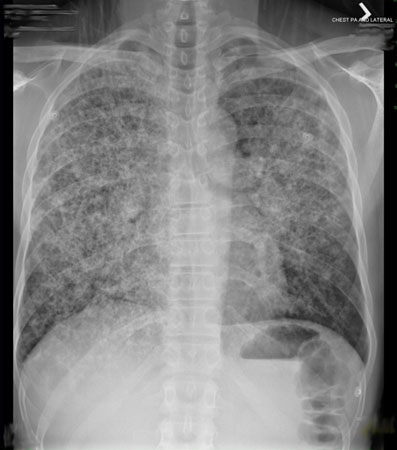Persistent pulmonary infiltrate results when a substance denser than air (e.g., pus, oedema, blood, surfactant, protein, or cells) lingers within the lung parenchyma. Non-resolving and slowly resolving pneumonias are the most common broad categories of persistent pulmonary infiltrate.[1]Menendez R, Perpina M, Torres A. Evaluation of non-resolving and progressive pneumonia. Semin Respir Infect. 2003 Jun;18(2):103-11.
http://www.ncbi.nlm.nih.gov/pubmed/12840791?tool=bestpractice.com
[2]Kuru T, Lynch JP 3rd. Non-resolving or slowly resolving pneumonia. Clin Chest Med. 1999 Sep;20(3):623-51.
http://www.ncbi.nlm.nih.gov/pubmed/10516909?tool=bestpractice.com
[3]Cunha BA. Slowly resolving and nonresolving pneumonias. Drugs Today (Barc). 2000 Dec;36(12):829-34.
http://www.ncbi.nlm.nih.gov/pubmed/12845341?tool=bestpractice.com
Persistence is attributed to defects in host immune defence mechanisms, presence of unusual or resistant organisms, or diseases that mimic pneumonia.[4]Mittl RL Jr, Schwab RJ, Duchin JS, et al. Radiographic resolution of community-acquired pneumonia. Am J Respir Crit Care Med. 1994 Mar;149(3 Pt 1):630-5.
http://www.ncbi.nlm.nih.gov/pubmed/8118630?tool=bestpractice.com
[5]Orens JB, Sitrin RG, Lynch JP 3rd. The approach to nonresolving pneumonia. Med Clin North Am. 2004 Feb;52(2):224-9.
http://www.ncbi.nlm.nih.gov/pubmed/8078373?tool=bestpractice.com
Classification
The classification of these disorders may become quite complex, as some clinicians focus primarily on radiological abnormalities, while others emphasise accompanying clinical features. Non-resolving or slowly resolving pneumonia is loosely defined as pneumonia that does not improve clinically, or even worsens, despite a minimum of 10 days of adequate antibiotic therapy or as radiographic infiltrate that does not resolve within 12 weeks.[6]El Solh AA, Aquilina AT, Gunen H, et al. Radiographic resolution of community-acquired bacterial pneumonia in the elderly. J Am Geriatr Soc. 2004 Feb;52(2):224-9.
http://www.ncbi.nlm.nih.gov/pubmed/14728631?tool=bestpractice.com
[7]Fein AM, Feinsilver SH, Niederman MS. Nonresolving or slowly resolving pneumonia: diagnosis and management in the elderly patient. Clin Chest Med. 1993 Sep;14(3):555-69.
http://www.ncbi.nlm.nih.gov/pubmed/8222569?tool=bestpractice.com
Slowly resolving pneumonia is usually defined as the persistence of radiographic infiltrate in a clinically improved patient for >4 weeks (<50% resolution in 1 month).[8]Eisenberg GM, Flippin HF, Israel HL, et al. Delayed resolution of pneumonias. Med Clin North Am. 1956 Sep;40(5):1291-303.
http://www.ncbi.nlm.nih.gov/pubmed/13358319?tool=bestpractice.com
[9]Kirtland SH, Winterbauer RH. Slowly resolving, chronic, and recurrent pneumonia. Clin Chest Med. 1991 Jun;12(2):303-18.
http://www.ncbi.nlm.nih.gov/pubmed/1855373?tool=bestpractice.com
[10]Rome L, Murali G, Lippmann M. Nonresolving pneumonia and mimics of pneumonia. Med Clin North Am. 2001 Nov;85(6):1511-30, xi.
http://www.ncbi.nlm.nih.gov/pubmed/11680114?tool=bestpractice.com
[11]Fein AM, Feinsilver SH. Non-resolving and slowly resolving pneumonia. In: Feinsilver SH, Fein AM, eds. Textbook of bronchoscopy. Baltimore, MD: Williams & Wilkins; 1995:286-301.
A waiting period of 12 to 14 weeks is suggested for slowly resolving pneumonia to be considered non-resolving (or chronic) in older patients with non-tuberculous bacterial pneumonia.[6]El Solh AA, Aquilina AT, Gunen H, et al. Radiographic resolution of community-acquired bacterial pneumonia in the elderly. J Am Geriatr Soc. 2004 Feb;52(2):224-9.
http://www.ncbi.nlm.nih.gov/pubmed/14728631?tool=bestpractice.com
Non-responding pneumonia is characterised by inadequate clinical response despite antibiotic treatment. It is an independent risk factor for death and delayed resolution of pulmonary infiltrate.[12]Menendez R, Torres A, Zalacaín R, et al. Neumofail Group. Risk factors of treatment failure in community acquired pneumonia: implications for disease outcome. Thorax. 2004 Nov;59(11):960-5.
http://www.pubmedcentral.nih.gov/picrender.fcgi?artid=1746855&blobtype=pdf
http://www.ncbi.nlm.nih.gov/pubmed/15516472?tool=bestpractice.com
[13]Menendez R, Torres A. Treatment failure in community-acquired pneumonia. Chest. 2007 Oct;132(4):1348-55.
http://www.ncbi.nlm.nih.gov/pubmed/17934120?tool=bestpractice.com
Non-infectious causes are responsible for about 20% of cases of non-resolving pneumonia.[12]Menendez R, Torres A, Zalacaín R, et al. Neumofail Group. Risk factors of treatment failure in community acquired pneumonia: implications for disease outcome. Thorax. 2004 Nov;59(11):960-5.
http://www.pubmedcentral.nih.gov/picrender.fcgi?artid=1746855&blobtype=pdf
http://www.ncbi.nlm.nih.gov/pubmed/15516472?tool=bestpractice.com
Therapeutic response
A good clinical response to pulmonary infiltrate is defined as a 50% clearing of chest radiographic findings at 4 weeks of therapy.[6]El Solh AA, Aquilina AT, Gunen H, et al. Radiographic resolution of community-acquired bacterial pneumonia in the elderly. J Am Geriatr Soc. 2004 Feb;52(2):224-9.
http://www.ncbi.nlm.nih.gov/pubmed/14728631?tool=bestpractice.com
Clinical improvement and resolution of leukocytosis support the conclusion that the patient has responded to antibiotic therapy, even when chest radiographic abnormalities persist.[2]Kuru T, Lynch JP 3rd. Non-resolving or slowly resolving pneumonia. Clin Chest Med. 1999 Sep;20(3):623-51.
http://www.ncbi.nlm.nih.gov/pubmed/10516909?tool=bestpractice.com
In the case of pneumonia, most patients have a normal temperature and decreased cough within 3 to 5 days after beginning treatment. When clinical improvement has not occurred and chest radiographic findings are unchanged or worse, or if at least partial radiographic resolution is lacking by 4 weeks, further evaluation is essential, even in asymptomatic patients.[2]Kuru T, Lynch JP 3rd. Non-resolving or slowly resolving pneumonia. Clin Chest Med. 1999 Sep;20(3):623-51.
http://www.ncbi.nlm.nih.gov/pubmed/10516909?tool=bestpractice.com
[10]Rome L, Murali G, Lippmann M. Nonresolving pneumonia and mimics of pneumonia. Med Clin North Am. 2001 Nov;85(6):1511-30, xi.
http://www.ncbi.nlm.nih.gov/pubmed/11680114?tool=bestpractice.com
[14]Woodhead M, Blasi F, Ewig S, Garau J, et al. Guidelines for the management of adult lower respiratory tract infections - full version. Clin Microbiol Infect. 2011 Nov;17 (Suppl 6):E1-59.
https://www.clinicalmicrobiologyandinfection.com/article/S1198-743X(14)61404-X/fulltext
http://www.ncbi.nlm.nih.gov/pubmed/21951385?tool=bestpractice.com
Variant response
Resolution of non-resolving pneumonia varies and depends on the causal agent, the severity of disease, and host factors.[4]Mittl RL Jr, Schwab RJ, Duchin JS, et al. Radiographic resolution of community-acquired pneumonia. Am J Respir Crit Care Med. 1994 Mar;149(3 Pt 1):630-5.
http://www.ncbi.nlm.nih.gov/pubmed/8118630?tool=bestpractice.com
[6]El Solh AA, Aquilina AT, Gunen H, et al. Radiographic resolution of community-acquired bacterial pneumonia in the elderly. J Am Geriatr Soc. 2004 Feb;52(2):224-9.
http://www.ncbi.nlm.nih.gov/pubmed/14728631?tool=bestpractice.com
Several risk factors may hinder the rate of radiographic clearing of the condition:[2]Kuru T, Lynch JP 3rd. Non-resolving or slowly resolving pneumonia. Clin Chest Med. 1999 Sep;20(3):623-51.
http://www.ncbi.nlm.nih.gov/pubmed/10516909?tool=bestpractice.com
[15]Cassiere H, Rodrigues JC, Fein AM. Delayed resolution of pneumonia: when is slow healing too slow? Postgrad Med. 1996 Jan;99(1):151-4, 157-8.
http://www.ncbi.nlm.nih.gov/pubmed/8539201?tool=bestpractice.com
Age >60 years: radiographic clearance of pneumonic infiltrate on completion of antibiotic therapy decreases by 20% per decade after the age of 20 years
Malnutrition
Comorbid conditions (COPD, cardiac failure, diabetes, renal failure, immunodeficiency, alcohol intake, smoking, occupational exposure, cancer, cancer treatment, systemic illness): patients with haematological malignancies; immunosuppressive disorders; or exposure to silica, aluminium, or titanium dust are prone to persistent pulmonary infiltrate
Causal micro-organism
Initial severity of the infection
Delay in initiation of therapy.
